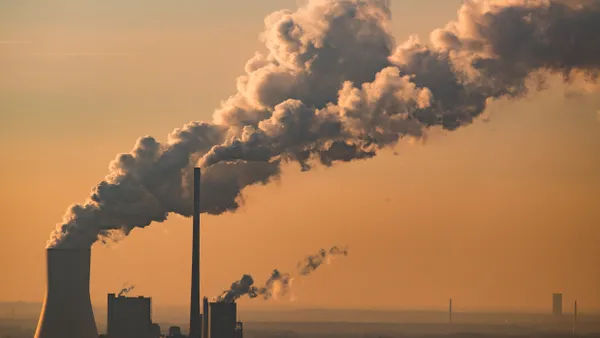Dive Brief:
- Deep retrofits in older commercial buildings and refrigerated warehouses are high-opportunity areas for speeding decarbonization, according to an inaugural commercial real estate report from the U.S. Green Building Council.
- To overcome space constraints of onsite renewable energy sources, taller and urban commercial buildings are increasingly looking to become zero-emissions-ready and will achieve that end when they procure clean power, said the report, State of Decarbonization: Progress in the U.S. Commercial Buildings 2023.
- The report calls for prioritizing the expansion and enforcement of “rigorous energy codes across all states” to meet current climate targets.
Dive Insight:
Based on an analysis of three decades of data, the USGBC’s report, produced in concert with Arup, found that the U.S. has made vital progress in decarbonizing commercial real estate and stated that the U.S. has “the tools it needs to reduce building-related emissions.”
Older commercial buildings, where pre-1980 buildings account for nearly 40% of gross commercial floor area in the U.S., could utilize nearly half of the expanded commercial energy efficiency tax deduction in the 2022 Inflation Reduction Act, which the report called a “key lever to decarbonization.” It described the act as a “generational investment in climate change with a substantial focus on decarbonizing buildings” and states that if IRA programs reach high participation levels, the law could enable the building sector to meet its proportional share of the U.S. Paris target early, by 2029.
The USGBC report notes that resources from the IRA are estimated to help cut U.S. greenhouse gas emissions by 20% below what a non-IRA scenario would generate by 2035. Another recent report from the U.S. Environmental Protection Agency pointed to a potential for IRA incentives to slash building emissions by up to 70% from 2005 levels, compared with a potential 36% to 51% decrease under a “no-IRA” scenario.
However, EPA projections indicate that the U.S. would have to reduce emissions by an additional 17% to achieve Paris Agreement targets in 2030. The USGBC report points to corporate decarbonization targets as a crucial factor in driving U.S. emission reductions, noting that about one-quarter of the largest commercial real estate investment trusts are making science-based commitments to decarbonizing buildings. Sixty-eight percent of Fortune 500 global companies published GHG reduction targets in 2022, compared with 6% in 2016, the report said.
While absolute commercial building emissions have decreased to 1990 levels, despite a 55% increase in U.S. commercial floor area over the same period, the U.S. must make more significant strides to fulfill its obligations under the Paris agreement, even when factoring in the anticipated effects of IRA investments, USGBC’s CEO, Peter Templeton, said in the report.
While decarbonization progress varies widely across the U.S., with urbanized metro areas and states in the process of implementing “systematic change,” the report says that commercial building decarbonization will scale as corporations continue to make climate commitments and report on emissions.
USGBC also noted that buildings in historically vulnerable communities see less investment and higher barriers to decarbonization, with low-income communities and communities of color lacking sufficient data to fully assess the conditions of building stock.
Offices, warehouses and education spaces are the three largest types of commercial buildings based on existing building square footage, the report said. It said that as companies adopt targets and develop transition plans, focusing on large buildings with high energy demand could “achieve greater reductions more quickly.” The USGBC highlighted the accelerated growth of warehouse and storage building stock in the past decade, attributing it to a surge in e-commerce and logistics. The organization underscored the significance of addressing warehouses in decarbonization efforts, given the continued expansion of their floor area.
Although the percentage of new construction projects meeting or exceeding the efficiency standards set by the American Society of Heating, Refrigerating and Air-Conditioning Engineers’ Standard 90.1-2010 decreased by 78% from 2017 to 2023, more than half of all states are currently using energy codes from 2013 or earlier, meaning almost half of new commercial area built in the next four years will be no more efficient than 2013 standards.












